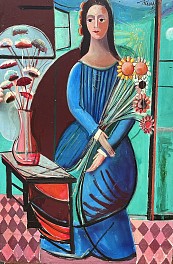BIOGRAPHY

Russian-American, 1899-1984
.Russian-Jewish-American artist Nahum Tschacbasov (1899-1984) is known for his cubo-surrealistic works
which feature a strong psychological element and a primative affect.
Most art admirers are probably unaware of the Tschacbasov’s prominence in
the United States. Born in Baku, Azerbaijan (a territory of Russia back in 1899), Tschacbasov was an
important figure in the New York art world from the 1930s to the 1950s, displaying his intricate, symbolladen
works in the halls of art havens like the Whitney Museum of American Art and the Metropolitan
Museum.
Tschacbasov was somewhat of a late starter, moving to Paris in 1932 to study under Adolph Gottlieb,
Marcel Gromaire and Fernand Leger. He had his first exhibition in Paris in 1934. He then returned to the
US where he joined Rothko and Gottlieb at the Gallery Seccession. He was one of the co-founders of The
Ten, a group of socially conscious abstract painters which included Rothko, Gottlieb, Joseph Solman and
Ilya Bolotowsky, among others.
In 1944, he began to work at Stanley Hayter's Atelier 17, a center for surrealistic ideas. Between 1936 and
1943, he had five one-man exhibitions at the ACA Galleries and participated in five group shows. He also
exhibited at the Whitney, the Pennsylvania Academy of Fine Arts, the Knox Albright Museum, the Chicago
Institute of Fine Art and Corcoran, among others. His work can be found in the permanent collections of
the Met, the Whitney, the Brooklyn Museum and the Jewish Museum.
Tschacbasov slipped off people’s radar in the 60s—we don’t know why—but has recently had several
retrospective exhibitions, including at the National Arts Club entitled: "Nahum Tscacbasov: A
Retrospective."
